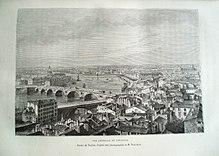History of Toulouse
People settled on the hills overlooking the river, in the modern locality of Vieille-Toulouse (literally "Old-Toulouse"), 9 kilometres (5.6 mi) south of present downtown Toulouse.
The historical name of the city, Tolosa (Τολῶσσα in Greek, and of its inhabitants, the Tolosates, first recorded in the 2nd century BC), researchers agree[citation needed] that it was probably Aquitanian (an ancestor of the Basque language), its meaning is unknown.
By 200 BC, Tolosa is attested on coins as the capital of the Volcae Tectosages (which Julius Caesar called Tolosates—singular Tolosas—in his Commentarii de Bello Gallico).
In 118 BC they founded the colony of Narbo Martius (Narbonne, the Mediterranean city nearest to inland Toulouse) and made contact with the Tolosates, noted for their wealth and the position of their capital for trade with the Atlantic.
In 109 BC the Germanic Cimbri tribe descended the Rhône Valley, invaded the Provincia and defeated the Romans, whose power was shaken along the recently conquered Mediterranean coast.
During the civil war following Nero's death, Tolosa native M. Antonius Primus led the armies of Vespasian into Italy, entered Rome in 69 AD and established the Flavian dynasty.
Another sign of imperial favor was Domitian's bestowal of the title of Palladia on the city in reference to Pallas Athena, goddess of arts and knowledge.
Palladia Tolosa was a major Roman city, with aqueducts, circus and theaters, thermae, a forum and an extensive sewage system.
In 313 the Edict of Milan established religious freedom in the empire, ending persecution of the Christians, and in 403 the Saint-Sernin basilica opened as a shrine for relics of Saint Saturnin.
I cannot speak without tears of Toulouse which has been kept from failing hitherto by the merits of its reverend bishop Exuperius", wrote Jerome to a Roman widow in 409 (Letters cxxiii.16).
[1] In 413 (three years after they sacked Rome), the Visigoths under King Ataulf captured Toulouse; under pressure from Roman forces, they soon withdrew south of the Pyrenees.
As Roman allies the Visigoths helped defeat Germanic invaders in Spain (notably the Suebi), taking advantage of their position to expand their territory south of the Pyrenees.
Although the Visigoths professed Arianism (a non-Trinitarian form of Christianity) and lived apart from their Gallo-Roman subjects, they were generally well accepted for bringing protection and prosperity.
Poor weather, plagues, demographic collapse and the decline of education and culture were common in the Frankish lands during the sixth and seventh centuries.
Unrecognized by the Merovingians, they ruled as kings in Aquitaine (including the Basque-speaking area of Gascony south of the Garonne) with their capital Toulouse.
Al-Samh ibn Malik al-Khawlani, wali (governor) of al-Andalus (Muslim Spain), mustered a strong army from North Africa, Syria and Yemen to conquer Aquitaine.
Charles Martel refused to help, wishing to take advantage of the situation to recover Aquitaine, and Odo led an army of Aquitanians and Franks to fight the Arabs.
Hunald was forced to accept Frankish authority, and Martel withdrew his troops from Aquitaine to attack Arab holdings on the Mediterranean coast near Narbonne.
Pippin, busy at home and sharing power with his brother, left Waifer in possession of Aquitaine and became sole ruler of the Frankish realm in 747.
Facing local resistance, including intervention by Duke Waifer, in 759 he captured Narbonne and ended Arab rule north of the Pyrenees.
It took the Franks eight years to subdue Aquitaine, Toulouse and Gascony; in 768, the last pockets of resistance crumbled as Duke Waifer was betrayed and murdered under mysterious circumstances.
Charlemagne saw that he could not trust the local nobility of Vasconia, appointing Frankish counts and creating counties (such as Fezensac) which could fight regional dukes such as Lupus.
Charles the Bald signed the 877 Capitulary of Quierzy, allowing counts to be succeeded by their sons, before his death four months later; this formed the basis of feudalism in western Europe.
During the 10th century civilization, the arts and education had declined; a rebirth of culture and order during the reign of Charlemagne was smothered by Viking invasions, augmented by poor weather and plagues which contributed to population loss.
Four years later, the Magyars launched a westward expedition and reached Toulouse before their defeat by Count Raymond III Pons.
Toulouse's proximity to Muslim Spain gave it a flow of knowledge and culture from the schools and printing houses of Córdoba, and it had retained more of the Roman legacy than northern France.
The bishop Foulques, who fought against the cathar heresy, encouraged the Albigensian Crusade and rebuilt the Toulouse Cathedral, making it the very first example of a militant architecture designed for preaching and to restore the image of the Catholic Church: the Southern French Gothic.
Convicted of heresy, Count Raimond VII died in 1249 without an heir; the county passed to the King of France, and the Capitouls' power weakened.
But in 1562 the French Wars of Religion began, disorganizing the trade, and moreover woad was eclipsed by indigo from India, which produced a darker, more-colorfast blue.
[4] In March 2012 local Islamic extremist Mohammed Merah opened fire at a Jewish school in Toulouse, killing a teacher and three children.
















